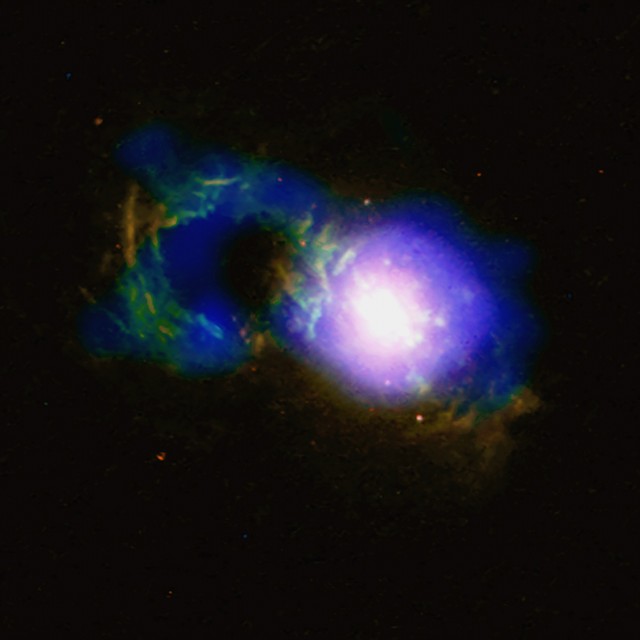Tempest In A Teacup Poem by Harley White
Tempest In A Teacup
Whether coffee or tea be your preference
or if to neither do you pay deference,
still people aplenty take time for a brew
in cherished traditions midst daily ado.
So maybe it shouldn't come as a surprise
that the stars would share in it high in the skies,
for such is the vision astronomers saw
which could make Carroll's Mad Hatter hem and haw.
Quasars, quasi-stellar radio sources,
are exceptionally luminous forces
quite active within nuclei galactic,
not to sound prosaically didactic.
The one nicknamed ‘Teacup' because of its form
in a galaxy far is breeding a storm.
They are saying the origin of the squall
is a supermassive black hole above all
positioned at the host star system's center
where infalling matter is forced to enter
due to the powerful gravity tugging—
more radiation's produced from the lugging.
The teacup's ‘handle' is really a ring
that's surrounding a bubble eruption fling,
so the whole appears fashioned into a cup
for celestial refreshment to be served up.
‘Tempest in a teacup' is an expression,
started by Cicero, first in succession
of linguistic adages which represent
a hyperbole for a minor event.
‘Ladle' was the vessel he chose to say it.
These days both ‘teapot' and ‘teacup' convey it.
Regardless of altered receptacle name,
through cultural changes the sense stayed the same.
Yet in this citation, the play on the phrase
a rather ironical meaning portrays,
since ‘Teapot' is pouring a whale of a gale
in Boötes on a gargantuan scale.
It is more than a billion light-years from here,
the locale of our minuscule earthly sphere,
where humankind's greed has gone out of control,
perhaps like the appetite of the black hole
that seeks to devour nearby material
in an aggressive manner imperial
even extending to the warping of time,
like the case of the Hatter sentenced for crime
of ‘murdering time', by the infamous Queen
of Hearts (oh that foul-tempered monarch was mean!) .
But the Hatter escaped her ‘off with his head'
making time take revenge by halting his tread
for the Hatter, who got stuck at six o'clock
with March Hare in afternoon tea-time deadlock.
‘Twas owing to the concert the regent held
where the hapless Hatter, alas, was compelled
to sing ‘Twinkle, Twinkle, ' a version with bat
above the world flying, which caused the great spat.
For he'd barely ended the very first verse
when the queen bellowed out her punishing curse…
Black holes don't figure in the tale's Wonderland,
still there's one that is powering quasar grand
in the cosmic galaxy vividly shown,
which might evoke matching tea-set of our own,
by Chandra and Hubble with hues for the scene
of x-ray in blue, optic light, red and green
in the image composite with teacup guise
that's bedazzling mortal terrestrial eyes.
So, let this reminder of temporal ways
help keep us grounded, as we raise a rapt gaze
to vastness beyond in the heavens above,
and strive for our lives to be labors of love.

Image and info ~ SDSS J1430+1339: Storm Rages in Cosmic Teacup…
Image and info ~ NASA's Chandra Space Telescope Captures the Tempest in a Cosmic ‘Teacup'…
A quasar-powered storm pours from the Teacup galaxy…
Time Might Be Running Backwards Inside Black Holes…
Alice's Adventures in Wonderland, by Lewis Carroll ~ Chapter VII ~ A Mad Tea-Party…
Image info ~ This composite image shows J1430+1339, known as the Teacup galaxy. Optical light (red and green)was taken by NASA's Hubble Space Telescope and X-ray data (blue)was collected by NASA's Chandra X-ray Observatory. The "handle" of the Teacup is a ring of optical and X-ray light surrounding a giant bubble. This handle-shaped feature, which is located about 30,000 light-years from the supermassive black hole, was likely formed by one or more eruptions powered by the black hole.
Image Credit: NASA/CXC/Univ. of Cambridge/G. Lansbury et al; Optical: NASA/STScI/W. Keel et al.
This poem has not been translated into any other language yet.
I would like to translate this poem